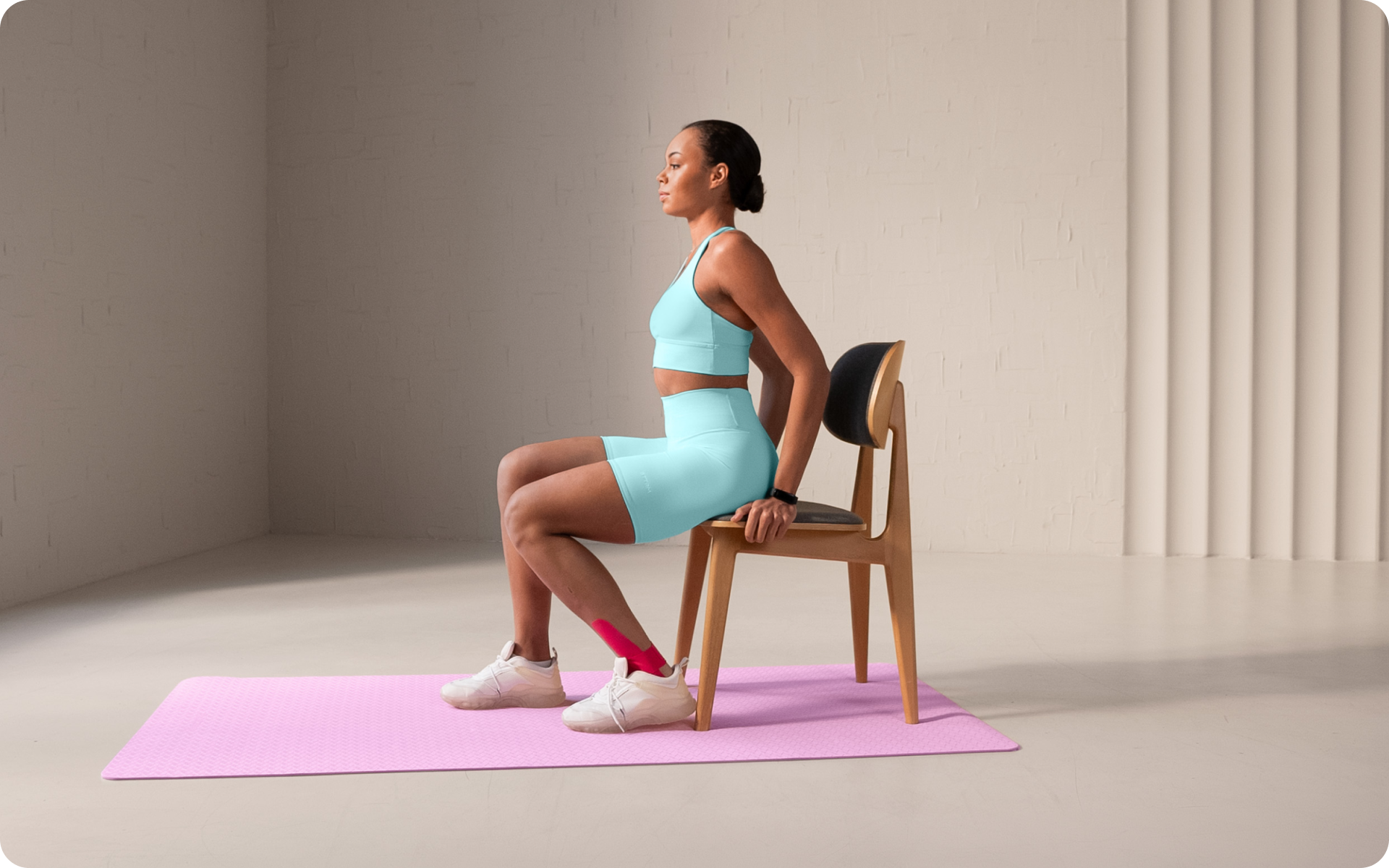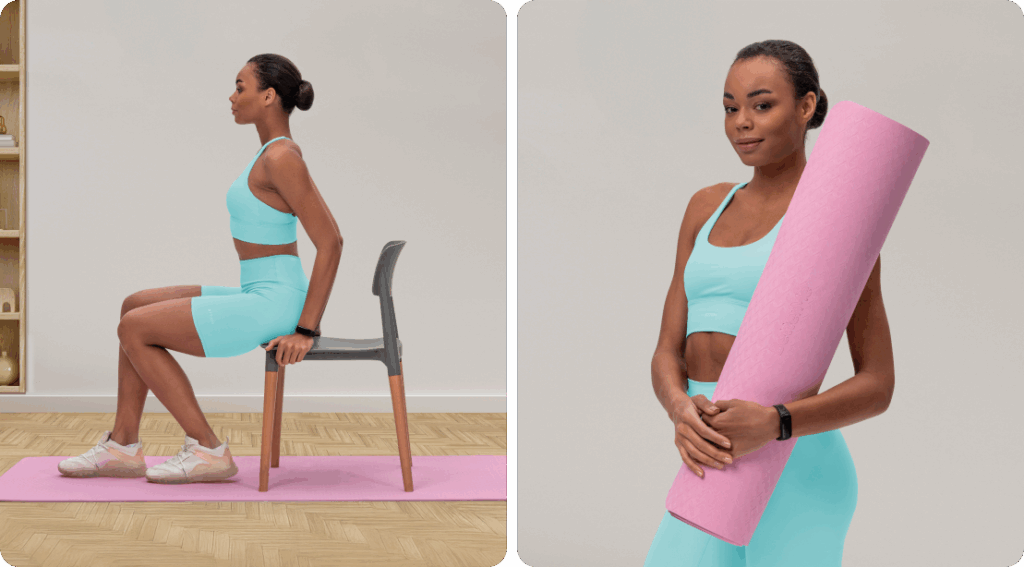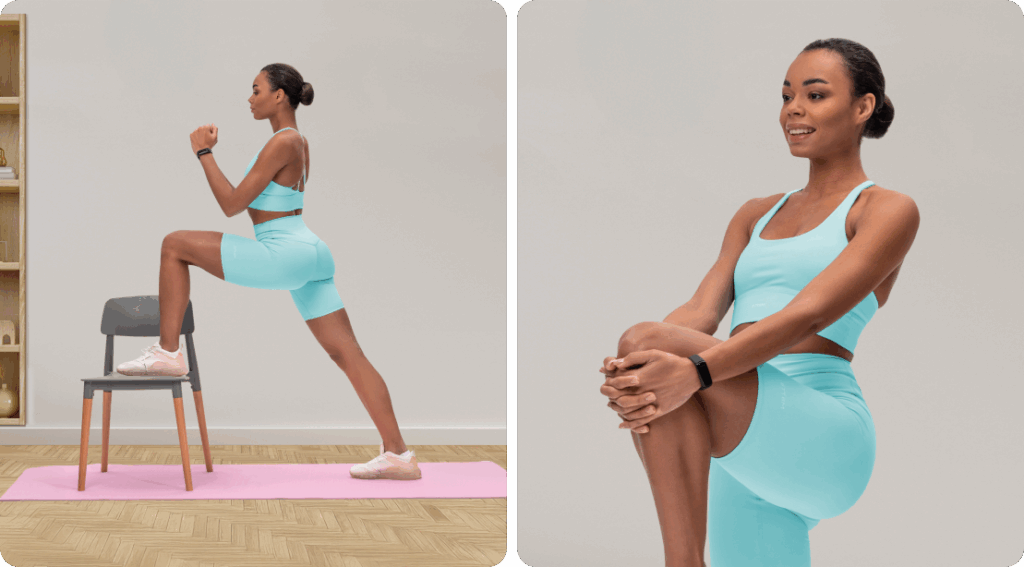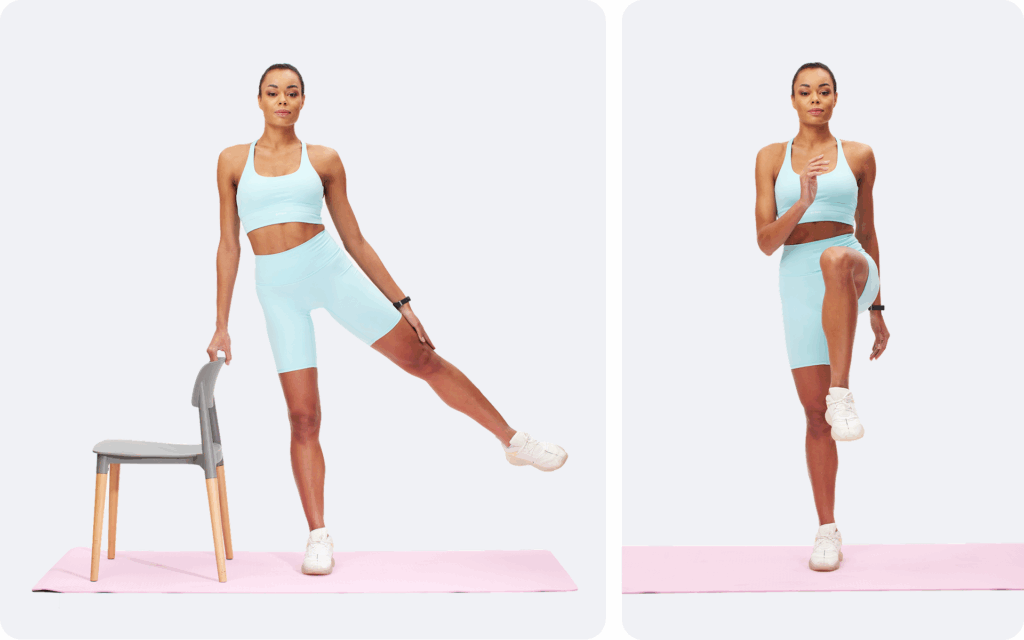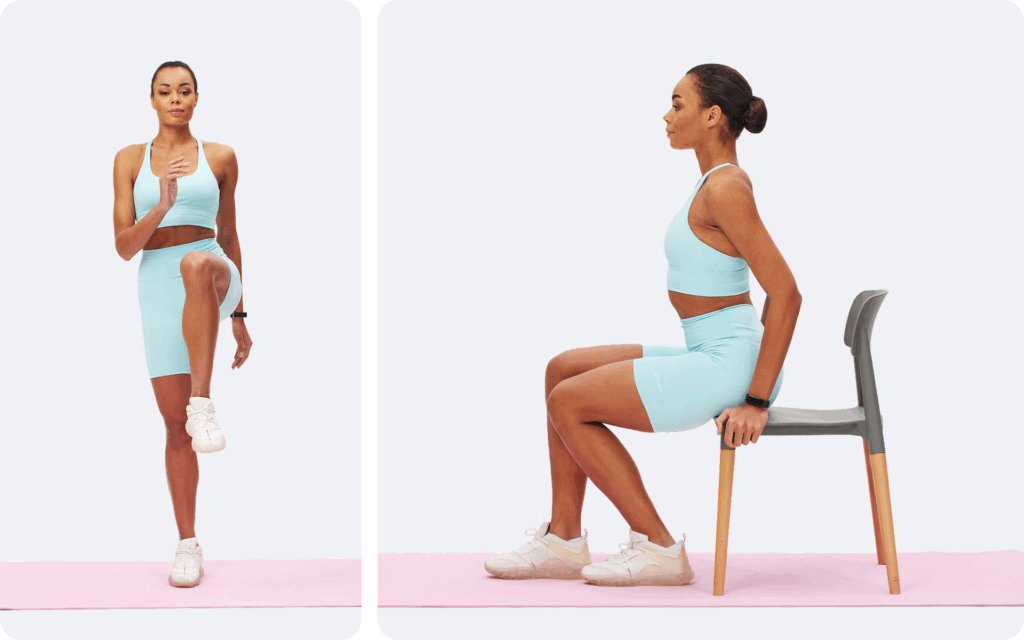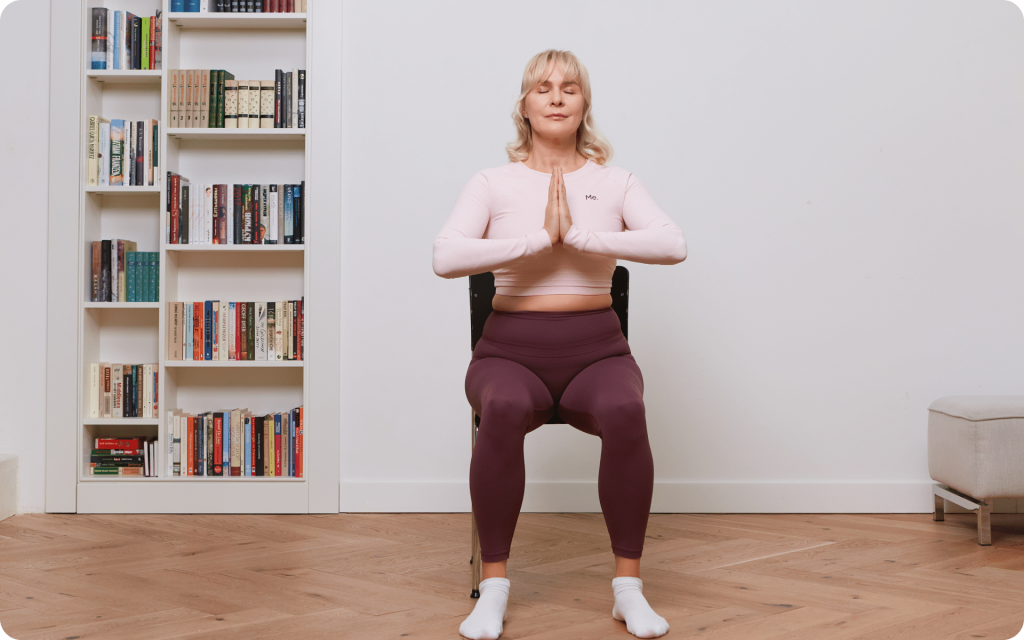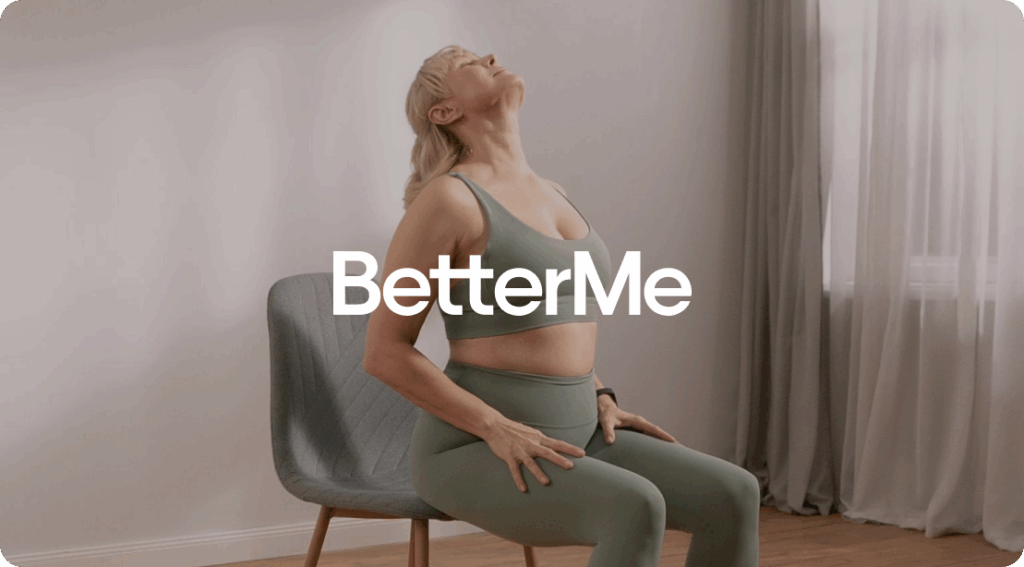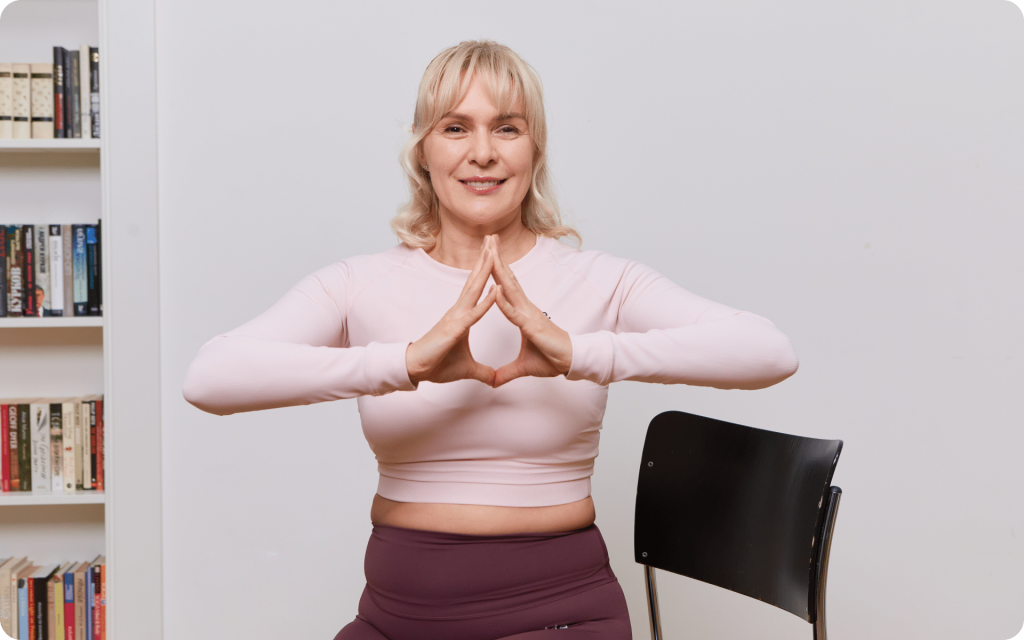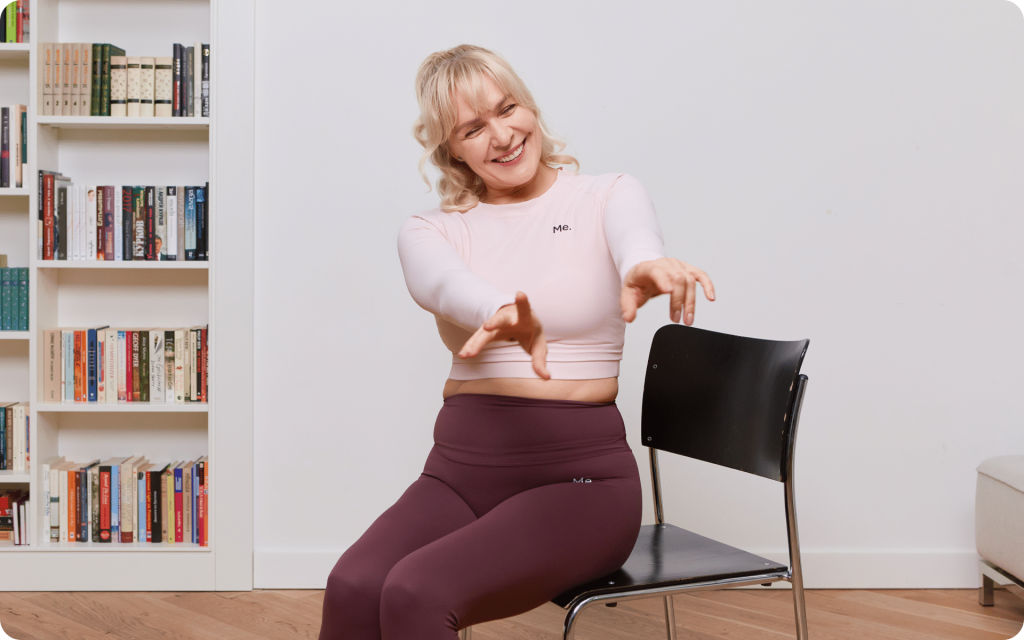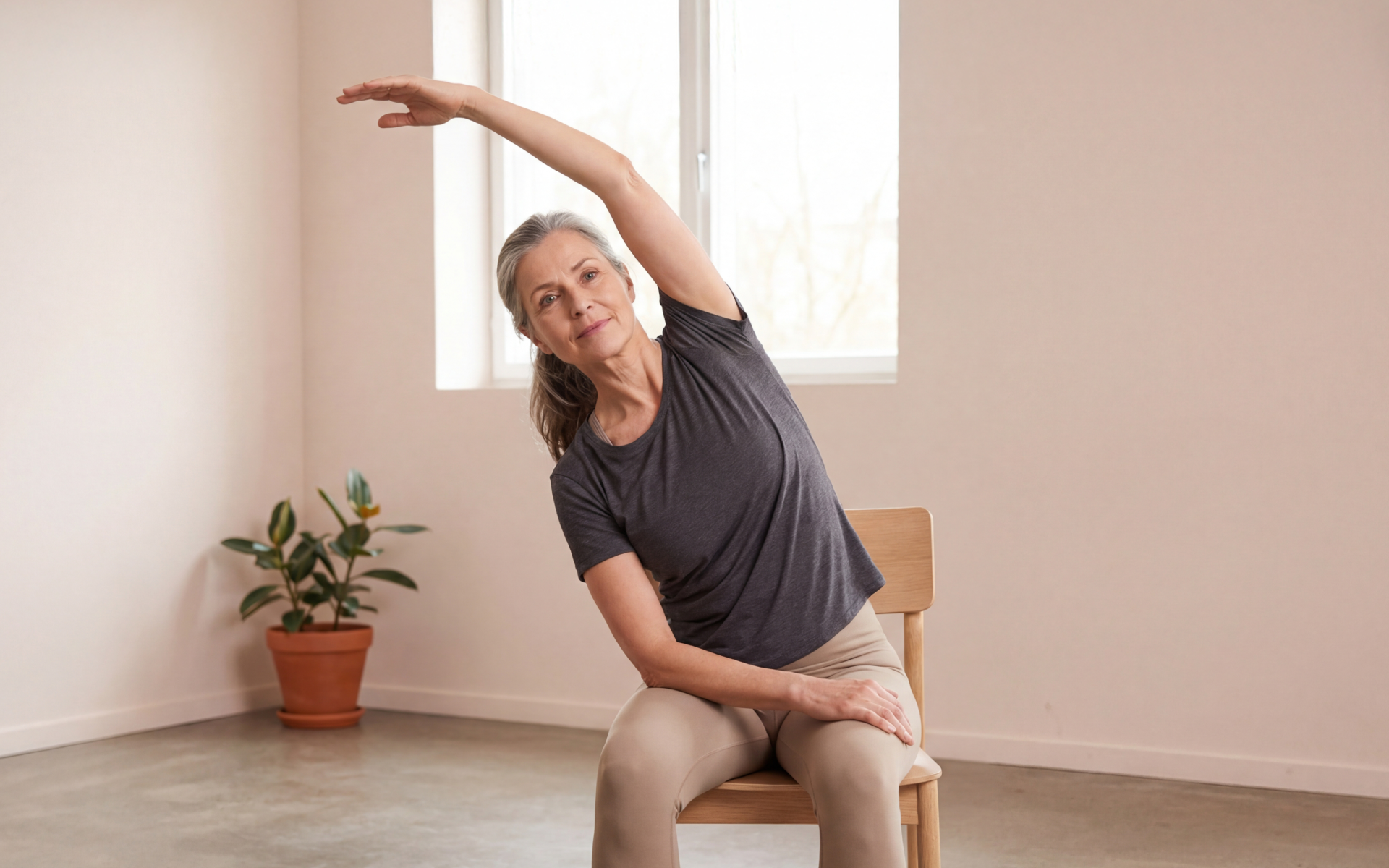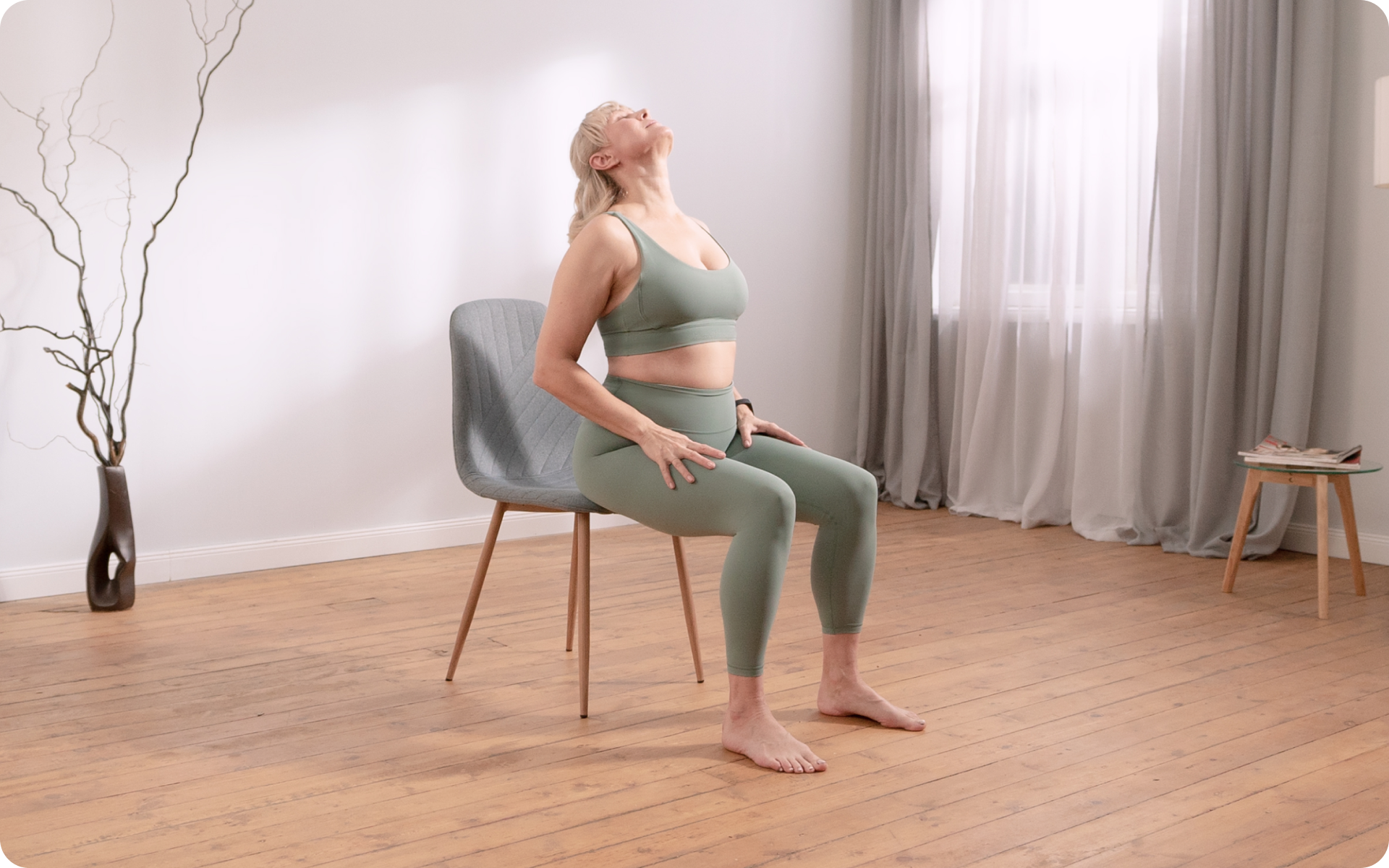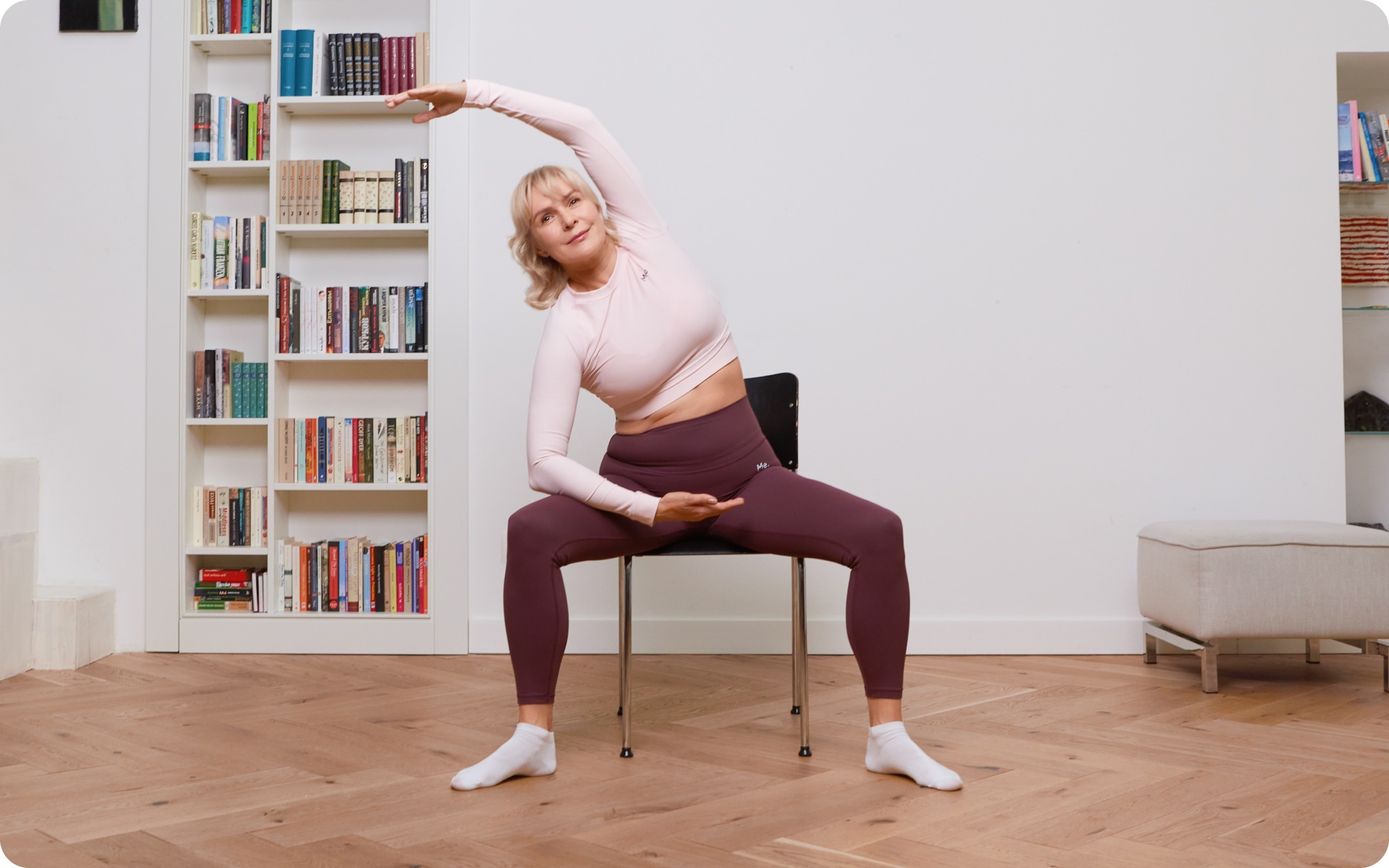Many people believe that limited mobility means giving up on the physical and mental benefits of yoga. However, this belief couldn’t be further from the truth.
Chair yoga provides a practical and accessible way to maintain flexibility, strength, and mental clarity, regardless of your current mobility level.
This guide provides 7 evidence-based chair yoga exercises specifically designed for individuals with limited mobility. You’ll discover how to create a gentle sequence that improves balance, reduces stiffness, and enhances overall well-being from the comfort and safety of a chair.
Whether you’re recovering from an injury, managing a chronic condition, or simply seeking a gentler approach to movement, these exercises can help you maintain an active lifestyle while respecting your body’s current limitations.
Can You Do Yoga With Limited Mobility?
Yes, you can absolutely practice yoga with limited mobility. Chair yoga adapts traditional yoga postures to make them accessible for people who cannot participate in floor-based classes or standing sequences.
Important note: Always consult with your doctor before beginning any new exercise program, especially if you have underlying health conditions, recent injuries, or chronic pain.
Chair yoga offers numerous evidence-based benefits for individuals with limited mobility:
What is adaptive chair yoga for limited mobility?
- Improved Balance and Stability
Regular practice of chair yoga can help improve strength, flexibility, and postural control.
These benefits support the muscles surrounding the spine and pelvis, which play a crucial role in maintaining balance (1).
Research shows that exercise programs combining strength and balance training can lower fall risk in older adults by about 20–30%, according to the CDC (2).
Chair yoga may therefore serve as a gentle and accessible option that contributes to some of these protective effects.
- Enhanced Flexibility and Range of Motion
Limited mobility often leads to muscle stiffness and joint restriction (3).
Chair yoga addresses tight muscles through gentle, controlled movements that maintain and improve flexibility without placing excessive stress on compromised areas.
A study published in the International Journal of Yoga found that yoga interventions (including seated stretches) can produce significant gains in spinal flexibility over a period of 6-8 weeks in those with low back pain (4).
The controlled environment of chair yoga allows you to work within your comfort zone while gradually expanding your range of motion.
Whether you’re a workout beast or just a beginner making your first foray into the world of fitness and dieting – BetterMe has a lot to offer to both newbies and experts! Install the app and experience the versatility first-hand!
- Reduced Pain and Muscle Tension
Chair yoga incorporates gentle stretches and movements that help release muscle tension, particularly in the neck, shoulders, and back areas commonly affected by prolonged sitting or limited activity (5).
The combination of movement and focused breathing activates the parasympathetic nervous system, which helps reduce pain perception and promote muscle relaxation.
Studies have reported a reduction in chronic pain symptoms following consistent chair yoga practice or targeted deep breathing (6, 7).
- Better Circulation and Joint Health
Seated movements promote blood flow to muscles and joints, which is especially important for individuals with limited mobility who may spend extended periods in static positions (1).
The gentle compression and release of muscles during exercise helps pump blood back to the heart, reducing swelling in the lower extremities and improving overall circulation (8).
- Stress Reduction and Mental Well-being
The mindful breathing and focused attention required in chair yoga activate the body’s relaxation response, significantly reducing cortisol levels and promoting mental clarity (9).
Research indicates that regular yoga practice, including chair-based variations, may help reduce anxiety and improve overall mood scores on standardized psychological assessments; however, further research is needed (10).
If you’re interested in exploring more gentle movement options, consider reading about the various indoor activities for seniors that complement chair yoga practice.
Read more: 5 Yoga Chair Pose Variations for Beginners to Try
Which Type Of Yoga Is Best For People With Limited Mobility?
The best chair yoga for limited mobility is the routine that fits an individual’s schedule, lifestyle, and abilities.
Overall, chair yoga stands out as the optimal choice for individuals with limited mobility due to its unique combination of safety, accessibility, and effectiveness.
Provides Stable Support
The chair serves as your foundation, eliminating balance concerns that might arise with standing or floor-based poses.
This stability allows you to focus entirely on the movements and breathing without worrying about falling or losing your balance.
You can use any sturdy, armless chair for practice. The seat should allow your feet to rest flat on the floor with your knees at approximately a 90-degree angle.
Easily Modifiable
A trainer can adapt a chair yoga routine to accommodate individuals with varying levels of mobility and comfort. You can adjust the range of motion, duration, and intensity based on your current capabilities and energy levels.
For example, if raising both arms overhead causes discomfort, you can modify the movement by lifting one arm at a time or reducing the height of the reach.
Requires No Special Equipment
Unlike other forms of adaptive exercise that may require specialized equipment or modifications, chair yoga can be practiced with just a chair and comfortable clothing.
This accessibility makes it easy to practice anywhere, whether at home, in care facilities, or even at the office.
Addresses Multiple Body Systems
Chair yoga simultaneously works on flexibility, strength, and breathing.
This comprehensive approach provides maximum benefit in minimal time, making it ideal for individuals who may have limited energy or attention span for longer exercise sessions.
Promotes Independence
The simplicity and safety of chair yoga mean you can practice independently once you learn the basic poses. This autonomy is particularly valuable for individuals who wish to maintain an independent and active lifestyle without relying on others for assistance.
For those seeking to enhance their balance further, incorporating static balance exercises alongside chair yoga can provide additional stability benefits.
What Are The Contraindications For Chair Yoga?
While chair yoga is generally safe for most people, certain conditions require caution or medical clearance before beginning practice.
- Severe osteoporosis requires special attention.
Avoid forward bending from the waist, extreme spinal twists, and any movements that involve significant spinal flexion until you can speak with your doctor. Instead, focus on gentle extension and maintain a neutral spine position.
- Recent abdominal, knee, or shoulder surgeries may contraindicate specific movements.
Always obtain clearance from your surgeon or physical therapist before practicing poses that involve the affected areas.
- We must address acute pain or inflammation in joints or muscles before beginning any exercise program.
Chair yoga should feel comfortable and gentle, never painful.
- Severe cardiovascular conditions may require monitoring during practice.
If you experience chest pain, severe shortness of breath, or dizziness during any pose, stop immediately and consult your healthcare provider.
- Pregnancy requires modifications, particularly avoiding deep forward folds and limiting the range of twisting movements.
Pregnant women should practice yoga only under the guidance of a qualified prenatal yoga instructor.
- Specific head movements or positions may aggravate severe balance disorders or vertigo.
Start slowly and avoid any movements that trigger symptoms. This focus on mindful, slow movement is vital in chair yoga for limited mobility beginners classes.
- Cognitive impairments may require supervision to ensure safe practice and prevent injury from confusion about positioning or movement instructions.
Remember that discomfort and pain are different sensations. Mild discomfort as muscles stretch is normal, but sharp, shooting, or severe pain indicates you should stop the pose immediately.
Read more: 10 Chair Yoga Poses For Beginners
What Are Some Chair Yoga Exercises For Limited Mobility?
These 7 carefully selected poses create a comprehensive sequence that addresses the major muscle groups while remaining safe and accessible for individuals with limited mobility.
Chair Mountain Pose (Chair Tadasana)
Chair Mountain Pose establishes proper posture and breathing awareness, serving as the foundation for all other poses in your sequence.
Steps to perform:
- Sit toward the front edge of your chair with feet flat on the floor, hip-width apart
- Lengthen your spine by imagining a string pulling the crown of your head toward the ceiling.
- Roll your shoulders down and back, away from your ears.
- Place your hands on your thighs or let them rest naturally at your sides.
- Close your eyes and focus on slow, deep breathing for 12 breaths.
- With each inhale, fill your lungs; with each exhale, release all tension.
Modifications: If your feet don’t comfortably reach the floor, place a cushion or yoga block under them for support. You can also put a small pillow behind your lower back for additional spinal support.
Chair Cat Cow Pose (Chair Marjaryasana Bitilasana)
This dynamic movement helps mobilize the spine and release tension in the back, neck, and shoulders.
Steps to perform:
- Start in Chair Mountain Pose with hands resting on your thighs
- Inhale and gently arch your back, lifting your chest and looking slightly upward (Cow position)
- Exhale and round your spine, tucking your chin toward your chest and drawing your belly button inward (Cat position)
- Continue this flowing movement for 8 slow, controlled repetitions.
- Move only as far as comfortable, focusing on the breath-movement connection.
Modifications: If neck movement causes discomfort, keep your head in a neutral position and focus only on the spinal movement.
You can also place your hands on your knees for additional support.
BetterMe: Health Coaching app helps you achieve your body goals with ease and efficiency by helping to choose proper meal plans and effective workouts. Start using our app and you will see good results in a short time.
Chair Pose On Chair Hands On Knees (Utkatasana On Chair Hands On Knees)
This pose strengthens the core muscles and improves spinal stability while maintaining the safety of seated practice.
Steps to perform:
- Begin in Chair Mountain Pose with your hands resting on your knees
- Inhale and lengthen your spine.
- Exhale and slowly lean forward from your hips, keeping your back straight and your core engaged.
- Stop when your torso reaches approximately 60 degrees of forward flexion.
- Keep your hands on your knees for support and engage your core muscles.
- Hold this position for 6 deep breaths.
- Inhale and slowly return to the upright position.
Modifications: If leaning forward causes discomfort, reduce the angle to 30-45 degrees. Focus on engaging your abdominal muscles rather than the depth of the forward lean.
Sun Salutation Variation Sitting On Chair (Surya Namaskar Variation Sitting On Chair)
This flowing sequence combines multiple movements to create a comprehensive warm-up that engages the entire body.
Steps to perform:
- Start in Chair Mountain Pose
- Inhale and raise both arms overhead, gently opening the chest.
- Hold for one breath, feeling the stretch through your torso.
- Exhale and fold forward from your hips, bringing your hands toward the floor.
- Hold for one breath in the forward fold.
- Inhale and slowly return to a sitting upright position.
- Exhale and lift your right knee, holding it with both hands
- Inhale and gently draw the knee closer to your chest, looking slightly upward.
- Exhale and bring your forehead toward your knee.
- Release your right leg and repeat the entire sequence with your left leg.
- Complete 2-3 full rounds, moving slowly and breathing deeply
Modifications: If lifting your knee is difficult, simply leave your foot on the floor and lean slightly forward instead. Adjust the range of motion in all movements to match your comfort level.
Cobra Pose Chair (Bhujangasana Chair)
This gentle backbend helps counteract forward head posture and opens the chest and shoulders, allowing for a more relaxed posture.
Steps to perform:
- Sit tall in Chair Mountain Pose
- Place your hands on your lower ribs or behind your head.
- Inhale and gently lift your chest, drawing your shoulder blades together.
- Keep your chin parallel to the floor and avoid tilting your head back excessively.
- Hold for 3-5 breaths, feeling the opening across your chest.
- Exhale and slowly return to the neutral position.
Modifications: If placing hands behind your head is uncomfortable, keep them on your thighs or lower ribs. Focus on the chest opening rather than how far you can extend backward.
Revolved Chair Pose On Chair (Parivrtta Utkatasana Chair)
This gentle twist helps maintain spinal mobility and can aid in digestion while strengthening the oblique muscles.
Steps to perform:
- Begin in Chair Mountain Pose
- Place your left hand on your right knee.
- Inhale and lengthen your spine.
- Exhale and gently rotate your torso to the right, placing your right hand on the back of the chair or on your hip
- Keep your hips facing forward and initiate the twist from your mid-back
- Hold for 4-6 breaths, feeling the gentle rotation through your spine.
- Return to the center and repeat on the opposite side.
Modifications: If reaching across to the opposite knee is difficult, simply place both hands on the same-side knee and twist gently in that direction. Limit the range of motion if you have any back issues.
Cobra Pose Chair (Bhujangasana Chair) – Relaxation Variation
End your sequence with a second, more relaxed version of Cobra Pose to integrate the benefits of your practice.
Steps to perform:
- Sit comfortably in Chair Mountain Pose
- Rest your hands gently on your thighs.
- Inhale and create a very gentle lift through your chest
- Allow this to be more subtle than the first Cobra Pose, focusing on relaxation.
- Hold for 5-8 deep breaths.
- Close your eyes and notice any changes in how your body feels.
- Gradually deepen your breathing and prepare to end your practice.
Modifications: Make this pose as gentle as possible. The goal is integration and relaxation rather than intense stretching.
For individuals interested in expanding their practice and improving mobility, exploring additional chair yoga for mobility options can provide variety and continued progress.
What Is An Easy Chair Yoga For Limited Mobility Workout Plan?
Now, let’s combine these poses into a flowing 15-minute sequence.
The key is to move mindfully, connecting each movement with your breath.
Total Time: Approximately 15 minutes
Centering (2 minutes):
- Begin in Chair Mountain Pose (Chair Tadasana).
- Close your eyes and take slow, deep breaths.
- Spend this time setting an intention for your practice and bringing your awareness to the present moment.
Warm-Up (3 minutes):
- Move into Chair Cat Cow Pose (Chair Marjaryasana Bitilasana).
- Flow smoothly between arching and rounding your spine for 8-10 breaths.
- This movement will gently warm up your back and prepare it for deeper movement.
Strengthening (3 minutes):
- Transition to Chair Pose on Chair (Utkatasana on Chair Hands on Knees).
- Hold the forward lean for 3-5 breaths, focusing on engaging your core.
- Rest for a breath, and then repeat the hold 2 more times to build strength in your back and abdominal muscles.
Dynamic Flow (4 minutes):
- Practice the Sun Salutation Variation Sitting On Chair (Surya Namaskar Variation Sitting On Chair).
- Move through the sequence 2-3 times, alternating which leg you bring toward your chest first. Focus on a smooth, continuous flow.
Heart Opening And Twisting (2 minutes):
- Perform Cobra Pose Chair (Bhujangasana Chair). Hold for 3 breaths to open your chest.
- Follow with Revolved Chair Pose on Chair (Parivrtta Utkatasana Chair). Hold the twist for 3 breaths on each side.
Cool-Down and Relaxation (5+ minutes):
- Settle into Corpse Pose on Chair (Savasana on Chair).
- Allow your body to relax completely.
- Stay here for at least 5 minutes to absorb the benefits of your practice.
- This resting period is a crucial part of the sequence, so don’t skip it.
If you enjoy this sequence, consider trying other chair yoga for mobility routines to keep your practice fresh and engaging.
Frequently Asked Questions
Can anyone do chair yoga?
Most people can do chair yoga, as it is a low-impact form of exercise that is highly adaptable.
It is particularly beneficial for seniors, individuals with limited mobility, or those recovering from injury. However, it is always recommended to consult a doctor before starting any new exercise program.
What is the difference between chair yoga and regular yoga?
The primary difference is the use of a chair for support.
In regular yoga, you would perform most poses, standing, sitting, or lying on the floor.
In chair yoga, these poses are modified to be performed while seated or using the chair for stability. This modification makes the practice more accessible for those who have difficulty with balance or transitioning between positions.
Do I need a special chair for chair yoga?
No, you do not need a special chair. A sturdy, stable chair without arms is ideal.
A dining room chair or a folding chair that doesn’t wobble will work perfectly.
Ensure the chair is placed on a non-slip surface to prevent it from moving during your practice.
Is chair yoga safe for seniors?
Yes, chair yoga is considered a very safe form of exercise for seniors.
The support of the chair reduces the risk of falls, and the gentle nature of the movements helps to improve strength, flexibility, and balance without putting excessive strain on the joints.
The Bottom Line
Chair yoga offers a powerful way to enhance your physical and mental well-being, regardless of your mobility level. Adapted traditional yoga poses to a seated format, it provides a safe, accessible, and effective way to build strength, improve flexibility, and find a sense of calm.
Remember to listen to your body, move with intention, and most importantly, enjoy the journey. With consistent practice, you’ll discover a renewed connection to your body and a greater sense of ease in your daily life.
DISCLAIMER:
This article is intended for general informational purposes only and does not serve to address individual circumstances. It is not a substitute for professional advice or help and should not be relied on for making any kind of decision-making. Any action taken as a direct or indirect result of the information in this article is entirely at your own risk and is your sole responsibility.
BetterMe, its content staff, and its medical advisors accept no responsibility for inaccuracies, errors, misstatements, inconsistencies, or omissions and specifically disclaim any liability, loss or risk, personal, professional or otherwise, which may be incurred as a consequence, directly or indirectly, of the use and/or application of any content.
You should always seek the advice of your physician or other qualified health provider with any questions you may have regarding a medical condition or your specific situation. Never disregard professional medical advice or delay seeking it because of BetterMe content. If you suspect or think you may have a medical emergency, call your doctor.
SOURCES:
- Chair Yoga and Why Seated Yoga Poses Are Good For You (2023, brownhealth.org)
- Participation in Older Adult Physical Activity Programs and Risk for Falls Requiring Medical Care, Washington State, 2005-2011 (2015, cdc.gov)
- Increase of resting muscle stiffness, a less considered component of age-related skeletal muscle impairment (2020, pmc.ncbi.nlm.nih.gov)
- Effect of Yoga on Stress, Anxiety, Depression, and Spinal Mobility in Computer Users with Chronic Low Back Pain (2022, journals.lww.com)
- Yoga For Tight Muscles and Pain: How It Works (n.d., fairviewrehab.com)
- Yoga for persistent pain: New findings and directions for an ancient practice (2016, journals.lww.com)
- The Effect of Deep and Slow Breathing on Pain Perception, Autonomic Activity, and Mood Processing—An Experimental Study (2012, academic.oup.com)
- Disrupting prolonged sitting reduces IL-8 and lower leg swell in active young adults (2019, bmcsportsscimedrehabil.biomedcentral.com)
- Fifteen Minutes of Chair-Based Yoga Postures or Guided Meditation Performed in the Office Can Elicit a Relaxation Response (2012, pmc.ncbi.nlm.nih.gov)
- Yoga for anxiety: A systematic review and meta-analysis of randomized controlled trials (2018, pubmed.ncbi.nlm.nih.gov)
